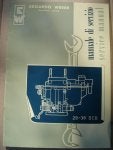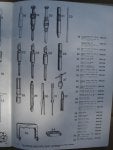This no doubt should be in carbs, fuel injection, etc. but to the best of my knowledge these carbs are only used on 750/101 Normales.
I installed this (new) carb on client's '62 1300 (now 1400) Giulia transition Spider. I've just started making test runs, but I'm having trouble getting a combination of advance/retard and (completely rebuilt Lucas distributor) and fuel. However I set both, the engine dies if the rpm drops to about 1700. If you're not familiar with this set-up, the tach starts at 1000.
I've found virtually no difference if I have the Idle Mixture Screw at a half turn or two full turns. However, I'm somewhat at a loss as to where the Throttle Adjustment Screw comes in. I'm assuming it is a version of the center adjusting screw on dual throat side draft Webers.
If you turn the TAS In (for instance) does this start to open the Primary Throttle Valve? And how can you tell if (another for instance) you turn it a full turn and nothing happens? I'll add that I can't tell if there is a bypass for the Primary Throttle Valve or not. I assume not.
I'm going to take a test run in a few hours and would like to have a better idea as to how and when to adjust the TAS
I installed this (new) carb on client's '62 1300 (now 1400) Giulia transition Spider. I've just started making test runs, but I'm having trouble getting a combination of advance/retard and (completely rebuilt Lucas distributor) and fuel. However I set both, the engine dies if the rpm drops to about 1700. If you're not familiar with this set-up, the tach starts at 1000.
I've found virtually no difference if I have the Idle Mixture Screw at a half turn or two full turns. However, I'm somewhat at a loss as to where the Throttle Adjustment Screw comes in. I'm assuming it is a version of the center adjusting screw on dual throat side draft Webers.
If you turn the TAS In (for instance) does this start to open the Primary Throttle Valve? And how can you tell if (another for instance) you turn it a full turn and nothing happens? I'll add that I can't tell if there is a bypass for the Primary Throttle Valve or not. I assume not.
I'm going to take a test run in a few hours and would like to have a better idea as to how and when to adjust the TAS













